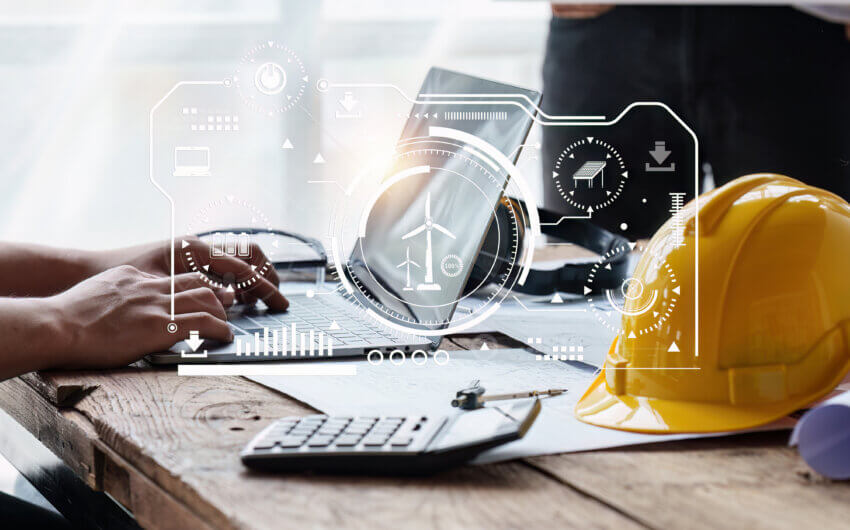Learn about hybrid machines and how AM and CNC complement each other
There is often discussion of “Additive vs. Subtractive manufacturing”, or whether 3D printing will replace CNC machining altogether. The reality is that when used together, additive and subtractive manufacturing can complement each other greatly. While CNC machining can be seen as a reliable workhorse, additive manufacturing allows us to create parts that couldn’t come to fruition otherwise. Recent advancements in the 3D printing industry have shown that the technology is now a staple in the manufacturing world. Here, we’ll discuss how the strengths of one technology can be used to support the downfalls of another and review some hybrid machines that combine both subtractive and additive into one machine.

3D printed soft jaws in a vice.
3D Printing in the Machine Shop
One way that a machine shop specializing in subtractive manufacturing can benefit from additive manufacturing is the use of 3D printing to create jigs, fixtures, and soft jaws. Even though jigs and fixtures are not part of the final product themselves, they can be costly to build because of the working hours required to machine them. Sometimes, they are even impossible to create on a mill or lathe, but can easily be 3D printed in a wide array of materials. Replacing machined fixtures and jigs with 3D printed versions saves time, money, and effort. They are usually 3D modeled anyway, so all that’s left is loading them into the 3D printer. 3D printed soft jaws are a fraction of the cost and can be remade to match any design changes for the final product in just a few hours. This leaves machinists much more likely to spend fifty dollars on 3D printing fixtures for design updates as opposed to five hundred dollars to have fixtures machined and remade.


A custom fixture 3D printed in nylon holds small, awkward parts without damaging them.
3D printing a fixture allows a machinist to fasten and position parts at difficult-to-hold angles. Markforged 3D printers are an excellent tool for this. With their high-strength, nylon-based filaments, which can be filled with carbon fiber, fiberglass, or kevlar during the printing process, they’re able to create robust, durable, and best of all, non-marring soft jaws, jigs, and fixtures. Even when working with delicate materials, 3D printed soft jaws won’t leave any marks on the part, resulting in fantastic surface finish quality.


Subtractive Machining for Additive Parts
3D printing doesn’t come without its challenges though. The surface quality of 3D printed parts can’t compete with injection molding and subtractive manufacturing. Flat surfaces suffer from being concave or convex. Holes are not true to size, and in many cases, aren’t even circular, but instead create an elliptical shape on the final print. Another problem with 3D printing, which often gets overlooked, is that they lack a true datum for geometric dimensioning and tolerancing.
Luckily, depending on the material, those commonly out-of-tolerance features created by additive manufacturing can be corrected with subtractive machining. By doing so, the final output is a part with the complex geometry of AM and the precision of CNC. With the correct feeds & speeds on a mill or lathe, warped walls can be flattened, holes can be bored to the correct diameters, and depending on the geometry, the surface can be refinished, all by removing material. These parts should be modeled in CAD with the intent of getting re-machined after 3D printing. For example, excess material (as little as approx. 0.02”) can be added in the 3D model to the surfaces or features getting machined, allowing enough buffer for material to be cut away, leaving more precise features.

A representation of a section view of a hole 3D printed with excess material to be machined to size.

Before and after refinishing.
Hybrid Manufacturing
Because 3D printing problems are now being solved using subtractive machining, there’s been a rise in machines that utilize both technologies, taking the idea of machining 3D printed parts even further. Known as Hybrid Manufacturing, these machines 3D print in metals, then mill away the unwanted material of the 3D printed features. Hybrid manufacturing is widely used in the aerospace, medical, automotive, and die and mold industries. 3D Hybrid, DMG Mori, and Hybrid Manufacturing Technologies are a few of the companies at the forefront of this new technology. These machines use Direct Energy Deposition (DED) additive manufacturing technology, in which a nozzle feeds powder along the printing surface and is then melted by beam or laser, which melts and then solidifies the metal. Initially, the surface of the 3D printed portion is rough, so after it’s deposited the subtractive CNC tools are used to smooth out the part.

Both adding and removing material on DMG Mori’s Lasertec 65 hybrid machine.
DED can print new parts or add to existing parts depending on the different stage of the manufacturing process. Since 3D printing can be done on existing parts, a great use of hybrid manufacturing is refurbishing and repairing old parts, which reduces waste. Scrap material is also reduced by shrinking the size of the required stock material. While traditional machining starts with a large block and leaves a pile of scrap material, the size of stock material for hybrid machining can be substantially smaller because extra features can be added individually at any time by the AM portion of the machine instead of being carved, leaving minimal waste.

A rock bit made of tungsten carbide repaired on a 3D-Hybrid machine.
ith incredible new machines and new companies popping up every year, the manufacturing industry is always changing. With these new technologies, a little creative problem solving can go a long way. So if you find yourself having trouble figuring out how to manufacture your design, remember that you’re not stuck with only one type of manufacturing and that by combining them you can create things that would’ve been nearly impossible to create before.
























